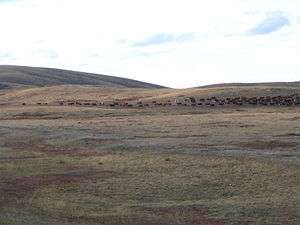Kazakh Uplands

The Kazakh Uplands (Kazakh: Сарыарқа - Yellow Ridge, Russian: Казахский мелкосопочник - Kazakhskiy Melkosopochnik), also known as the Kazakh Hummocks, is a large peneplain formation extending throughout the central and eastern regions of Kazakhstan. It consists of low mountain oases (Karkaraly, Kent, Kyzylarai, Ulytau, etc.) and elevated plains, and contains large deposits of coal in the north and copper in the south. Rare species, such as the Asiatic cheetah, may still live in the region. Several notable cities, including the country's capital, Astana, are located there.
Part of the Kazakh Uplands are included in the Saryarka — Steppe and Lakes of Northern Kazakhstan world heritage site. It is of the Palearctic temperate grasslands, savannas, and shrublands ecoregion of the temperate grasslands, savannas, and shrublands biome.
External links
- Kazakh Uplands Encyclopædia Britannica
- "Kazakh upland". Terrestrial Ecoregions. World Wildlife Fund.
- Казахский мелкосопочник (Kazakh Uplands) Great Soviet Encyclopedia (in Russian)
- Kazakh Uplands on "Nomadic Travel Kazakhstan" web-site
 Media related to Steppes in Kazakhstan at Wikimedia Commons
Media related to Steppes in Kazakhstan at Wikimedia Commons
| Wikimedia Commons has media related to Kazakh Uplands. |
Coordinates: 50°26′00″N 69°11′20″E / 50.4333333433°N 69.1888888989°E
| Alai-Western Tian Shan steppe | Kazakhstan, Tajikistan, Uzbekistan |
| Altai steppe and semi-desert | Kazakhstan |
| Central Anatolian steppe | Turkey |
| Daurian forest steppe | China, Mongolia, Russia |
| Eastern Anatolian montane steppe | Armenia, Iran, Turkey |
| Emin Valley steppe | China, Kazakhstan |
| Faroe Islands boreal grasslands | Faroe Islands, Denmark |
| Gissaro-Alai open woodlands | Kyrgyzstan, Tajikistan, Uzbekistan |
| Kazakh forest steppe | Kazakhstan, Russia |
| Kazakh steppe | Kazakhstan, Russia |
| Kazakh Uplands | Kazakhstan |
| Middle East steppe | Iraq, Syria |
| Mongolian-Manchurian grassland | China, Mongolia, Russia |
| Pontic steppe | Kazakhstan, Moldova, Romania, Russia, Ukraine, Bulgaria |
| Sayan Intermontane steppe | Russia |
| Selenge-Orkhon forest steppe | Mongolia, Russia |
| South Siberian forest steppe | Russia |
| Tian Shan foothill arid steppe | China, Kazakhstan, Kyrgyzstan |